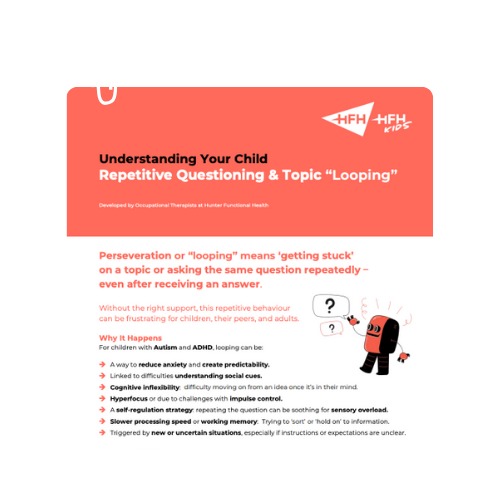When Your Child Gets ‘Stuck’: Understanding Repetitive Questioning & Topic Looping
We’ve all had moments where we can’t stop thinking about something — a question we want answered, an idea we can’t let go of. For some children, this happens often, and it can feel like they’re “stuck” in a loop.
This behaviour is called perseveration, and it means getting stuck on a thought, a question, a feeling, or an action — even after it’s been answered or resolved. For example, a child might ask the same question again and again, worry about something that’s already been addressed, or replay a past conversation in their mind.
Perseveration: It’s Not Stubbornness
Perseveration isn’t about being defiant or trying to annoy others. Children don’t do it on purpose — in fact, they often don’t even realise they’re doing it.
It’s like their brain is caught in a loop and doesn’t yet know how to switch tracks. This can be frustrating for you and your child, but it’s important to remember that it’s a sign of underlying challenges, not a behaviour to punish.
Why It Happens
For children with Autism, ADHD, or sensory processing differences, perseveration can be linked to:
Anxiety — seeking predictability to feel safe.
Sensory overload — repeating can be calming.
Cognitive inflexibility — finding it hard to switch from one thought to another.
Slow processing speed — needing more time to sort through information.
Hyperfocus — becoming deeply absorbed in one thought.
Impulse control challenges — struggling to stop the thought or question.
Unclear expectations — not knowing what’s coming next.
“Perseveration isn’t about children being defiant or trying to annoy others. It’s like their brain is caught in a loop and doesn’t yet know how to switch tracks.”
Signs Your Child Might Be Perseverating
Perseveration can show up in different ways:
Asking the same question repeatedly.
Focusing on one worry long after it’s been addressed.
Replaying past events or conversations.
Repeating the same action or fidgeting.
Getting “stuck” on an emotion such as anger or fear.
Supporting Your Child to Get ‘Unstuck’
The goal isn’t to “make it stop” instantly — it’s to help your child feel secure, know what to expect, and build the skills to move forward.
Here are a few starting points:
Talk about it when they’re calm
Explain what you’ve noticed and give it a name (“getting stuck”) so they can start to recognise it themselves.Respond with empathy
Perseveration can be a way of coping with anxiety or overwhelm. A calm, understanding response can help lower that anxiety.Use visual anchors
Charts, schedules, or progress trackers give them something concrete to refer to instead of looping back to the question.Create a “Question Carpark”
Write down repeated questions so they feel heard, then revisit them at an agreed time.Practise flexibility through play
Games where the rules change slightly each round help children adapt to new situations.Preview what’s ahead
Reduce uncertainty by looking at upcoming events, activities, or tasks together.
When Extra Support Can Help
If perseveration is affecting your child’s daily life at home or school, occupational therapy can help identify triggers, build regulation strategies, and develop flexibility skills. Sometimes, sensory strategies or executive functioning support make a big difference.




